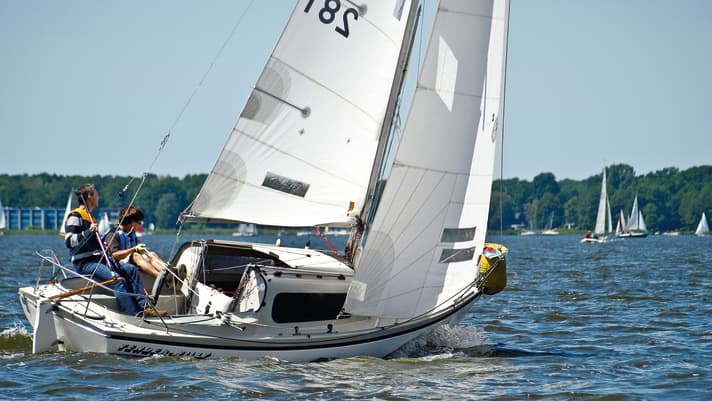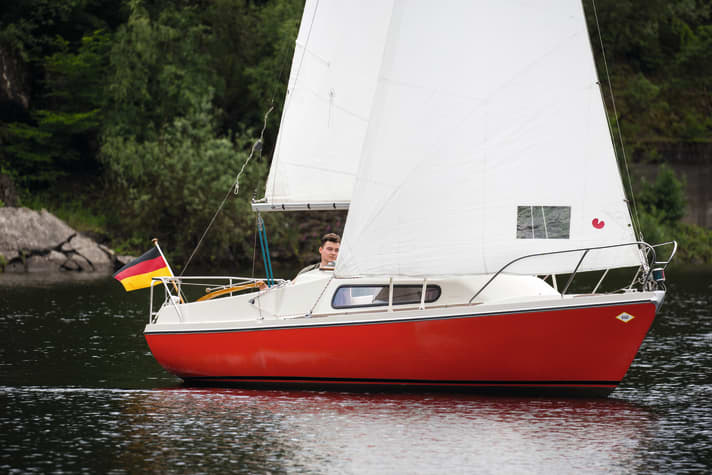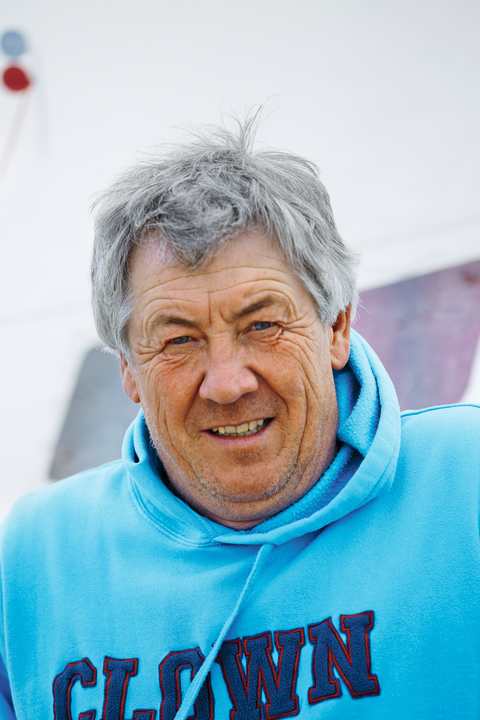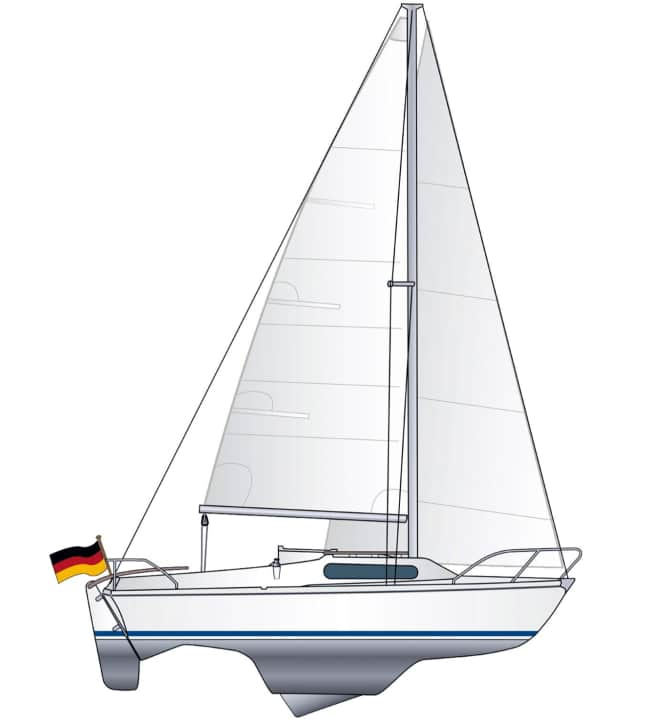Varianta: The class association for Willi Dehler's successful model is 50 years old
Nils Leiterholt
· 21.01.2024






- The role of cruising sailors in the class association
- An electrician becomes a shipyard manager - the emergence
- Model maintenance characterised the Dehler shipyard
- The class association at boot Düsseldorf
- How realistic is a European Varianta Championship?
- Frank Schönfeldt about the regattas in the Varianta class
- Model history: The "Vari" development
When a type of boat is more than half a century old and still brings together fields that some current regatta classes are far removed from, you can call that a curiosity. The fact that this applies to the Varianta of all boats is another astonishing phenomenon, because, as its name suggests, its creators van de Stadt and Dehler once designed it for everything but regatta sailing.
However, the class association of the first German production boat of its kind is still one of the most active in the country today. And for the almost 500 members, there was another reason to celebrate in 2023, as their class association turned 50 years old - half a century in which a lot has happened.
This also applies to boat building. The material GRP made modern series production possible and ships became ever faster and more voluminous as the competition between shipyards intensified.
When Willi Dehler realised his dream of building series boats around 60 years ago and started thinking about the Varianta, he had neither a role model nor any competition. And yet the result was a boat that many sailors still regard as the ideal representative of its kind.
The Varianta supports beginners and challenges professionals
For good reason. The Varianta is a real all-rounder. While it is manageable and good-natured for beginners, others sail their boats in ten to twelve regattas a year. Varianta - the word also harbours an emotional value for the vast majority of owners, as many have been sailing it their whole lives.
Thomas Overkämping, for example. He was the second chairman and technical chairman of the class association until 2023 and says of his liaison with the boat: "I've been sailing Varianta since 1989. It's just something that, once you've started, you can't get away from it. It's simply brilliant."
In addition to sporting ambition, what counts most is the community. "Everyone helps everyone else here. What is the exception in other classes is completely normal for us," says Overkämping, who they all just call "Shorty". "We don't crash into each other's boats on the regatta course, we prefer to pull back once more. And before there's a protest, we'd rather curl up." So it's no surprise that there have been no protests at the German championships for six years.
Despite the relaxed attitude, there are many good sailors among the Variantas. One of the most prominent is the Hamburg sailmaker Frank Schönfeldt who became German champion 15 times.
Last summer, 23 boats took part in the German championship on the Großer Plöner See. And the regatta calendar for 2024 includes 18 regatta weekends.
Unfortunately, many sailors were lost during the coronavirus period, says Overkämping. Some have found new hobbies, others have reached old age. Nevertheless, he is not worried about the existence of "his" class association: "New members are joining. We've had a fairly constant 500 members in recent years."
The role of cruising sailors in the class association
The age spectrum, including at the regattas, is very mixed. In the Varianta, sailors aged between 17 and 70 can usually be found at the class regattas. One reason for this is that the boats are stable in value and comparatively inexpensive. "If you spend between 5,000 and 7,000 euros on a K3 or K4, you can sit on it and set off without any problems," says Overkämping. There are also some crews who sleep on the Variantas during regattas, which keeps their costs down. On the other hand, older sailors can still compete on the boat.
Around 100 members of the class association are active regatta sailors. But the cruising sailors are also catered for. Last season, for example, around 15 members and their Variantas went on a flotilla cruise together. It went around Rügen. A joint cruise is also planned for 2024 and will take place in the Wadden Sea at the end of May. And since the coronavirus era, a digital regulars' cruising group has been established.
There are many examples of remarkable journeys with the Varianta. We have already reported on 2022 in our small cruise report about Christian Dörges. He sailed around the entire Baltic Sea with a friend on his Varianta 65 "Fliege".
With the Varianta to Bornholm- everything is possible
From Großenbrode, they travelled across the Bay of Mecklenburg via Denmark and Sweden to Bornholm. The return journey took the crew via Rügen and along the German coast. At the time, the then 64-year-old teacher in early retirement reported that he had continued to improve with his Varianta 65. First they sailed around Funen and to Samsø, but after their positive experiences they wanted to improve and declared Bornholm their dream destination.
This story also shows that many owners grow with their Varianta. Some sail the boat at home on their inland lake and one day set off with it to try their hand at coastal sailing for the first time. The simplicity of the systems on the Varianta certainly helps here, and it can also be towed on the trailer with a mid-range car.
An electrician becomes a shipyard manager- the emergence
Willi Dehler, the founder of the family shipyard of the same name, was actually an electrician and ran a specialised electrical shop in Dortmund. Through his Opel dealer, he then came to the Dortmunder Yachtclub on Lake Möhne at the end of the 1950s.
"Some club members were the owners of the first boats there, but unlike today, they were moored in a buoy field," recalls Willi Dehler's son Karl, who was born in 1956. To get to the boats, rowing boats were needed, which were made of wood at the time and often did not survive the winter without damage.
"As my father was already familiar with GRP from sailing the Stern dinghy, he decided to use it to build a weather-resistant boat for sailing into the buoy field," says the founder's son, describing the history of the Dehler shipyard.
And so Willi Dehler began to design and build the Winnetou in 1963. He initially built the boat as a hobby in his garage.
Through his acquaintance with a Bremen dealer, from whom Willi Dehler bought the fittings for the Winnetou, he was given the opportunity to exhibit at the Interboot trade fair in Friedrichshafen on Lake Constance. "As the sailors on Lake Constance had the same problem with the dinghies in the buoy field, the Winnetou became a bestseller and was sold over 40 times at the trade fair," says Karl Dehler. To be able to build them all, Willi Dehler rented a cinema room and laminated his Winnetous there.
However, the step towards full-time production boat building only came two years later with the Varianta. And its birth was also a rather coincidental idea of the innovative Willi Dehler.
When he was looking for a suitable sailing boat for his family at the Hamburg boat show in 1964, he did not find what he was looking for. None of the boats on offer met his requirements. He wanted a trailerable and capsize-proof plastic boat with a cabin for overnight stays. "But that didn't exist at the time. And just as the founder of Porsche said that the car he wanted didn't exist and he therefore had to build it himself, my father started to think about how such a boat could be created," remembers Karl Dehler.
Through an old connection, his father knew the Dutch yacht designer E. G. van de Stadt, who was already renowned at the time. He had designed the Randmeer dinghy, which is still popular today as a school boat. "Van de Stadt scaled up its design, added a removable cabin, and that's how the Varianta was born," says Karl Dehler, describing the design of the first Varianta.
From the Ruhr region to the Sauerland
Appropriate premises were now also required for the planned series production of the Varianta. The search for a suitable production facility led Willi and his wife Edith Dehler to Meschede-Freienohl in the Sauerland region. There, they had the opportunity to take over the workshop of a timber company that no longer existed. The property and hall were idyllically situated on the banks of the Ruhr, but the local authority awarded it on the condition that at least 15 people were employed.
Inspired by a large dose of optimism, Willi Dehler sold his electrical business in Dortmund. His brother Heinz also sold his house to join the business, and together they founded Dehler Bootsbau OHG in Freienohl.
Heinz Dehler, four years younger than his brother Willi, was entrusted with the commercial aspects of the company and received 49 per cent of the OHG. Willi Dehler, the founder and driving force, held a slim majority of 51 per cent.
The Dehler brothers presented their first Varianta at the Hamburg boat show in January 1966, and 27 buyers were found straight away. However, all of them agreed to a trial sail beforehand, which ultimately convinced every interested party and later caused no one to cancel their order.
The Varianta quickly became very popular, especially on inland waterways. "The hardtop was originally intended as an option at the time, but my father quickly realised that almost all buyers opted for it," summarises Karl Dehler.

Willi Dehler carried out the first sailing test with a colleague on the Möhne dam in 1965. As the "Westphalian Sea", the area is still the Mecca for "Vari" sailors and is still home to the largest fleet. The distance to the former Dehler site in Freienohl is only 30 kilometres.
Model maintenance characterised the Dehler shipyard
And so, just one year later, the Sauerland shipyard launched the Varianta K4 onto the market. Its main purpose was to revolutionise coastal sailing and provide berths for four people in the small cabin. Hence the name "K4". It also had a new, self-draining cockpit and a fixed cabin superstructure. Both were intended to convey a feeling of greater safety.

The model-maintained Varianta 65 came onto the market in 1972. Her coaming is slightly higher than on the other models. This resulted in a more sheltered cockpit and slightly more living space. In addition, like the K4, it was equipped with four berths and had a galley.
The Varianta 65 had a draught of up to 1.30 metres. With the ballast centreboard raised, it had a draught of 70 centimetres. Production of the Variantas was only discontinued in 1982; with around 4,500 units, it was Germany's best-selling cabin cruiser.

In addition to many innovative ideas, it was remarkable that the Variantas were sold with a trailer as standard. These were produced in Dehler's own metalworking shop in Freienohl. The system with the slip carriage pulled on the trailer is still valued today.
Back then, however, the ability to slip the boat independently was much more important than it is today. "Back then, not all harbours and marinas had a crane, and even a slipway was not always available," recalls Karl Dehler of his early youth.
The class association at boot Düsseldorf
A very important event for the class association is boot Düsseldorf. Every year, the Varianta class presents itself with its own boat in the Sailing Centre in Hall 15. This is only possible thanks to a great deal of voluntary commitment.
Thomas Overkämping is responsible for this trade fair appearance in 2024, as he has been for many years. "The Varianta Class Association's presence at boot has grown historically," says Overkämping. He also reports that this year, with 21 helpers, there is more manpower available than ever before.
The stand is an important meeting point for Varianta sailors. Whether they are interested in racing or cruising, everyone comes to the stand in Hall 15 to exchange ideas. Not only is there a boat to marvel at every year, but also a hot coffee. Or, if you prefer, a sip of sherry.
According to Overkämping, the trade fair appearance costs the class association two and a half thousand euros every year. And that doesn't include the petrol costs of the volunteers. However, the boot is an important membership recruitment tool for the class association. Every year, 15 to 20 visitors join the class association. In addition, contacts with each other and with the other classes are actively cultivated here.
Around twelve to 15 members can also be recruited regularly throughout the year through existing contacts alone. "When someone joins our sailing club and comes with a Varianta, I ask them directly if they are a member of our class association," says Overkämping.
Strong fleet captains are also of fundamental importance in recruiting new members. They are also important for the articles in the printed "VA Infos", which are published every six months at boot and in late summer.
A total of eight fleet commanders have divided up the entire federal territory. There are individual fleet commanders for Berlin, Southwest, Schleswig-Holstein, Steinhuder Meer, Baldeneysee, Möhnesee, Sorpesee and Hennesee.
How realistic is a European Varianta Championship?
There was also a time when those responsible briefly dreamed of organising a European Championship in the Varianta. At that time, however, the required number of international entries was just not reached, and in the meantime the number of regatta participants from Austria and Switzerland has declined to such an extent that it is no longer an option.
In addition to the Möhne, the hotspots for Varianta sailors are Berlin and the Mannheim area. There they race the Varianta on an arm of the Old Rhine. However, this area is known above all for its hospitality. Some people don't just go there for the sailing, says Thomas Overkämping. In fact, the Mannheim Sailing Association is so obliging and friendly and the atmosphere on the tranquil branch of the Old Rhine is so good.
This attitude is typical of life in the Varianta Class Association. In addition to the ambitious, sporting aspect, the members are primarily concerned with the community.
Thomas Overkämping also emphasises how balanced the chemistry in the class association is and that a lot has happened in the last 20 years. "We used to sit at many an annual general meeting and spend three hours just discussing whether or not the genoa luff extrusion should be pulled out of the cockpit."
But those days are over. Although passionate discussions still take place at meetings, the class rules have been relaxed to such an extent that motions on technical issues usually result in a majority in favour of giving it a try.
Overall, Thomas "Shorty" Overkämping is positive about the future of the Varianta Class Association: "With the resignation of the first chairman and myself, we wanted to give the younger members the opportunity and the stage to contribute their fresh ideas more strongly. I'm excited to see what's in store for us."
Frank Schönfeldt about the regattas in the Varianta class

YACHT: Mr Schönfeldt, you were German champion in the Varianta 15 times, but last year it didn't work out ...
Frank Schönfeldt: ... we simply didn't train enough last year, and the others are too strong for that. But this year we want to attack again at the German Championships on Lake Baldeney!
YACHT: How did you actually come to sail the Varianta?
Frank Schönfeldt: There were almost no Variantas up here. Nevertheless, a customer asked me to make him a set of sails in 1988. But he came back a few weeks later and wanted to return the sails. I told Hannes Diefenbach at the Blankenes Sailing Club, we knew each other from the Pirate. He said: "My father has a Varianta on Lake Sorpe, should I bring it along and we can test your set of sails?" That's what we did. I mean on sail number G3, but certainly on one of the first ones. We then won the German championship by a large margin and I made a lot of friends. However, the dates of the championships overlapped with those of Pirat and OK-Jolle, so I stopped again. At the stand in Düsseldorf, however, they got me back on board.
YACHT: What makes the Varianta so special for you?
Frank Schönfeldt:It's super easy to get into the Varianta, you basically can't sail a regatta more favourably. Above all, I enjoy it because the community is simply great. I would be delighted if there was an active Varianta class association for many years to come.
The birth of the class association
As early as 1969, when the Varianta was just five years old, owners interested in regattas formed an association with the support of the Dehler shipyard to promote regatta sport with the Varianta. In May 1971, the German Sailing Association recognised it as a standard class. On 20 February 1973, ten Varianta sailors met in Freienohl to officially found the Varianta Class Association. Shipyard boss Willi Dehler was also a founding member. Josef Schulte-Feldmann from Sorpesee in Sauerland was elected as the first chairman, whose first task was to fulfil all the formalities and conditions for the recognition of a class association.
Model history: The "Vari" development
The Varianta was modelled twice. The K3 and K4 versions hardly differed in terms of dimensions and appearance. The Varianta 65, on the other hand, differed more significantly, as the comparison shows.

Technical data of the first Varianta model:
- Designer:E. G. van de Stadt
- Torso length over all:6.40 metres
- Length of the waterline:5.30 metres
- Width:2.10 metres
- Draught (centreboard):0.50/0.70 to 1.30 metres
- Berths:3
- Ballast:260 kg
- sail area:22,5 m²
- Mast length:7.30 metres

Technical data of the Varianta 65:
- Designer:E. G. van de Stadt
- Torso length over all:6.50 metres
- Length of the waterline:5.40 metres
- Width:2.10 metres
- Draught (centreboard):0.50/0.70 to 1.30 metres
- Berths: 4
- Ballast:280 kg
- sail area:22,5 m²
- Mast length:7.20 metres

